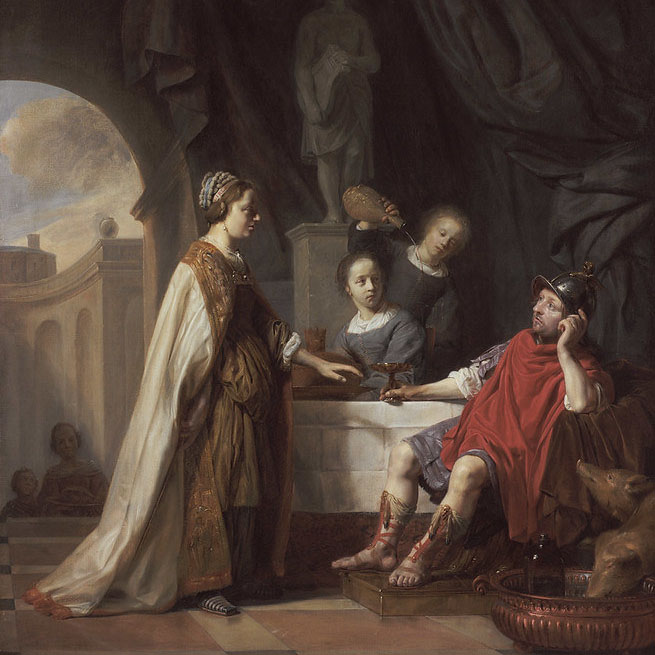Vassar College Exhibition “Changing Forms: Metamorphosis in Myth, Art, and Nature, 1650–1700”

Willem van Mieris (1662–1747), Portrait of Dina Margareta de Bye, 1705, The Leiden Collection, New York

Salomon de Bray (Dutch, 1597–1664), Ulysses and Circe, ca. 1650, The Frances Lehman Loeb Art Center, Vassar College, Poughkeepsie, NY
Tue, Sep 28 - Sun, Dec 19 2021
Changing Forms: Metamorphosis in Myth, Art, and Nature, 1650–1700, curated by Dr. Elizabeth Nogrady, Andrew W. Mellon Curator of Academic Programs at the Loeb, and Dr. Lara Yeager-Crasselt, Curator of The Leiden Collection, brings together approximately twenty paintings, drawings, prints, specimens, and illustrated books to explore the rich and varied concept of “metamorphosis” in the late seventeenth-century Netherlands. With links to art, myth, science, and the exchange of knowledge, metamorphosis provides a vital lens through which to explore and understand an evolving early modern world.
Changing Forms focuses on the idea of metamorphosis at a dynamic moment in the late 1600s, when the notions of myth, art, and science converged in new, urgent ways. Painters such as Godefridus Schalcken, Willem van Mieris, and Samuel van Hoogstraten created their own mythological imagery with the more refined and elegant language of classicism. This tradition will be demonstrated in the exhibition by works such as Samuel van Hoogstraten’s Salmacis and Hermaphroditus (ca. 1671–76), which has never before been shown in a museum exhibition, as well as paintings of the goddess Diana by Godefridus Schalcken and Willem van Mieris, all on loan from The Leiden Collection, the preeminent private collection of Dutch art in the United States.
At the same time, the exhibition demonstrates how contemporaries explored biological metamorphosis in lavishly illustrated insect studies. Key books to emerge in this context were Johannes Goedaert’s Metamorphosis naturalis and Maria Sibylla Merian’s Metamorphosis insectorum Surinamensium, which amassed new knowledge from Indigenous and enslaved people in South America. These stunning books come from Vassar collections and include significant loans from Cornell University, Bard College, and Lehigh University. A centerpiece of the exhibition is Willem van Mieris’ Portrait of Dina Margareta de Bye (1705) from The Leiden Collection, which represents this learned woman from Leiden with flowers, shells, paintbrushes, and a painting of a butterfly that closely resembles a page from Merian’s text. It thus exemplifies the fascinating intersection of art, nature, and metamorphosis that unites the exhibition.
The exhibition will be accompanied by an exhibition catalogue published by the Loeb Art Center with new scholarship on these themes by Elizabeth Nogrady, Lara Yeager-Crasselt, and Ronald Patkus.

Samuel van Hoogstraten (1627-1678), Salmacis and Hermaphroditus, ca. 1671–76
The Leiden Collection, New York
About the Frances Lehman Loeb Art Center
The Frances Lehman Loeb Art Center was originally established in 1864 as the Vassar College Art Gallery. The current 36,400-square-foot facility, designed by Cesar Pelli and named in honor of the new building's primary donor, opened in 1993. Vassar was the first U.S. college founded with an art museum as a part of its original plans, and at any given time the galleries of the Loeb feature works from its extensive collections. The Loeb’s collections chart the history of art from antiquity to the present and comprise over 22,000 works, including paintings, sculptures, drawings, prints, photographs, and ceramic wares. Notable holdings include the Warburg Collection of Old Master prints, an important group of Hudson River School paintings given by Matthew Vassar at the college's inception, and a wide range of works by major European and American 20th-century artists.
Admission to the Frances Lehman Loeb Art Center is free and all galleries are wheelchair accessible. The Loeb is now open to the public Tuesday to Sunday from 10am to 5pm and Thursdays until 7pm. The Loeb is located at 124 Raymond Avenue near the entrance to the Vassar College campus.